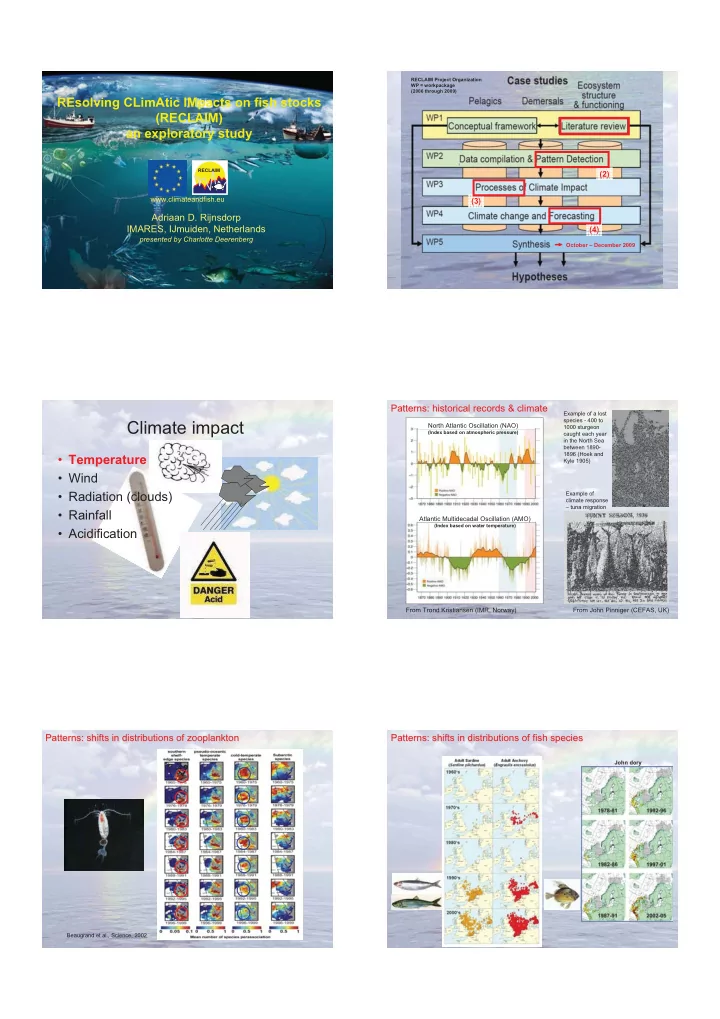

RECLAIM Project Organization WP = workpackage (2006 through 2009) REsolving CLimAtic IMpacts on fish stocks (RECLAIM) an exploratory study RECLAIM (2) www.climateandfish.eu (3) Adriaan D. Rijnsdorp IMARES, IJmuiden, Netherlands (4) presented by Charlotte Deerenberg October – December 2009 Patterns: historical records & climate Patterns: historical records & climate Example of a lost species - 400 to Climate impact North Atlantic Oscillation (NAO) 1000 sturgeon (Index based on atmospheric pressure) caught each year in the North Sea between 1890- 1896 (Hoek and • Temperature Kyle 1905) • Wind • Radiation (clouds) Example of climate response – tuna migration • Rainfall Atlantic Multidecadal Oscillation (AMO) (Index based on water temperature) • Acidification From Trond Kristiansen (IMR, Norway) From John Pinniger (CEFAS, UK) Patterns: shifts in distributions of zooplankton Patterns: shifts in distributions of zooplankton Patterns: shifts in distributions of fish species Patterns: shifts in distributions of fish species John dory Beaugrand et al., Science, 2002
Patterns: recruitment variation variation Patterns: recruitment area Patterns: recruitment Patterns: recruitment area Particle tracking models- origin of late larvae in the North Sea Climate effect depends on position in geographical range of species MIK larvae Models suggest differently 1.0 Assumed come from West of Scotland sprat North Sea spawning sites 0.8 Orkney- Cumulative Fraction 0.6 Shetland Buchan Banks 0.4 0.2 Downs Unknown 0.0 1990 1995 2000 2005 2010 Year Payne & Dickey-Collas, in prep. MacKenzie & Koster (2004) Ecology Processes: temperature affects habitat Processes: temperature affects habitat Processes: salinity affects habitat Processes: salinity affects habitat Late larvae: Late larvae: habitat changes but environment habitat changes with environment stays the same Juveniles Juveniles: Juveniles: habitat changes but environment tend to remain at same temperature stay the same grey line- environment grey line- environment dark line- herring habitat dark line- herring habitat Processes: coupled 3- Processes: coupled 3 -d biophysical modelling d biophysical modelling Processes: pressures on fish stocks interact Processes: pressures on fish stocks interact climate impact on growth & survival of fish early life stages drift of eggs and larvae ���� Fish Fish Baltic Sea ���� - NAO + NAO Larval Food Eggs Larvae ���� Risk that cod will disappear mismatch match ���� ���� ���� ���� ���� �� ��� ��� ��� ��� ���� Time 60° N potential survival % �� Model-based 58° N �� Survival �� 56° N Estimates �� Atlantic Cod 54° N �� 52° N �� 1996 1992 50° N �� average NAO - January -April � ��� � ��� ��� ��� ��� � ��� ��� ��� From Ute Daewel, Hamburg / Bergen
Projections: temperature Projections: temperature and precipitation Projections: temperature Projections: temperature and precipitation changes from 1980-1999 to 2080-2099 ������ �������� �������� ������ ������ . ����� IPCC, 2007 From IPCC 2007, working group 1 Projections: Projections: „ „what if what if“ “ scenarios phytoplankton productivity scenarios phytoplankton productivity Projections: „ Projections: „what if what if“ “ scenarios fish stock productivity scenarios fish stock productivity Temperature Wind North Sea: Results from 3-D ECOSMO model Largest changes for 1 o C 2 o C wind and increase in solar radiation +20% Radiation -20% 3 o C 4 o C Drinkwater 2005 Projections: Projections: „ „what if what if“ “ scenarios spawning time scenarios spawning time Conclusions: models Conclusions: models Anchovy in the Bay of Biscay Global climate models (GCM) show: • temperature increase • change in rainfall Combined scenario: • uncertainty about wind (probably an increase) spawning occurs • decrease sea ice approximately 1 month earlier • but GCM unable to hindcast AMO and NAO � GCMs should be improved to capture the decadal (NAO) and multidecadal (AMO) scale variations � Regional downscaling needed
Conclusions: interaction climate change and fisheries Conclusions: impact climate change on fish Conclusions: interaction climate change and fisheries Conclusions: impact climate change on fish Distribution shifts (polewards, into deeper water) • but mechanism still obscure Fishing increases sensitivity to climate change • may result in regime shifts Increase in biodiversity > likely increase in resilience of ecosystems Climate change may increase the sensitivity to other anthropogenic factors Changes in productivity expected • Increase in stratification (temperature / salinity) • Probably positive for pelagics • Probably negative for demersals • But differences between areas Conclusions: fisheries and management implications Conclusions: fisheries and management implications Distributional shifts (across management areas) What are your most important questions • fish more difficult to catch? about impacts of climate change? • economic consequences • may influence allocation of fishing rights / TAC’s • may reduce effectiveness of Marine Protected Areas Productivity changes • management reference points will change New species management � More uncertainty > precautionary approach � Robust management > ecosystem approach Art: Glynn Gorick Patterns: management implicatins Patterns: management implicatins REsolving CLimAtic IMpacts on fish stocks RECLAIM Shifts to deeper waters: undersized plaice leave the ��������� protected area “Plaice Box” (red lines) � increased discards http://www.climateandfish.eu/ ���� ���� RECLAIM Partners IMARES –IMARES, Institute for Marine Resources & Ecosystem Studies, The Netherlands ( www.imares.nl ) CEFAS– Centre for Environment, Fisheries & Aquaculture Science, UK ( www.cefas.co.uk) DTU-Aqua – National Institute of Aquatic Resources,Technical University of Denmark ( www.dfu.dtu.dk ) FRS – Fisheries Research Services, UK ( www.marlab.ac.uk ) IFREMER – Institut Français de Recherche pour l’Exploitation de la mer, France ( www.ifremer.fr ) IHF-UH – University of Hamburg, Germany ( www.biologie.uni-hamburg.de/ihf ) IMR – Institute of Marine Research, Norway ( www.imr.no ) NIOZ – Royal Netherlands Institute for Sea Research, The Netherlands ( www.nioz.nl ) UiB-GFI – University of Bergen, Geophysical Institute, Norway ( web.gfi.uib.no ) Van Keeken et al. 2007 Journal of Sea Research
Recommend
More recommend